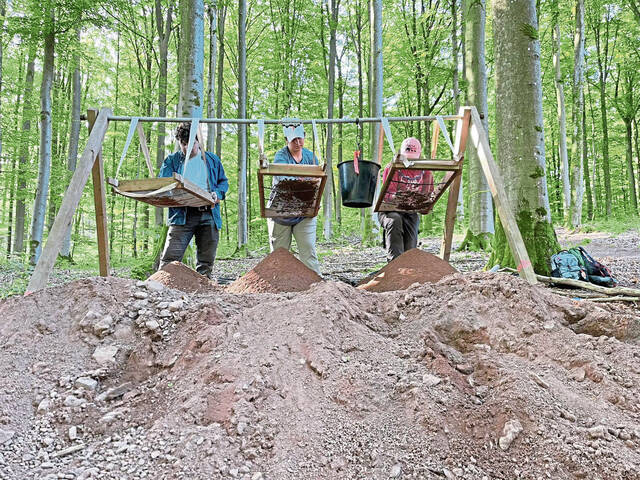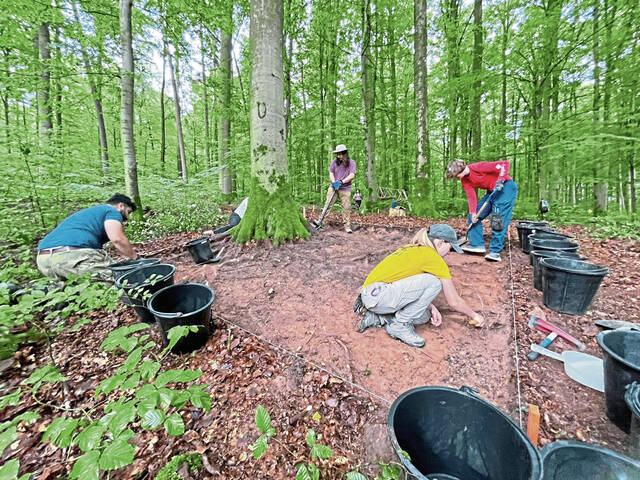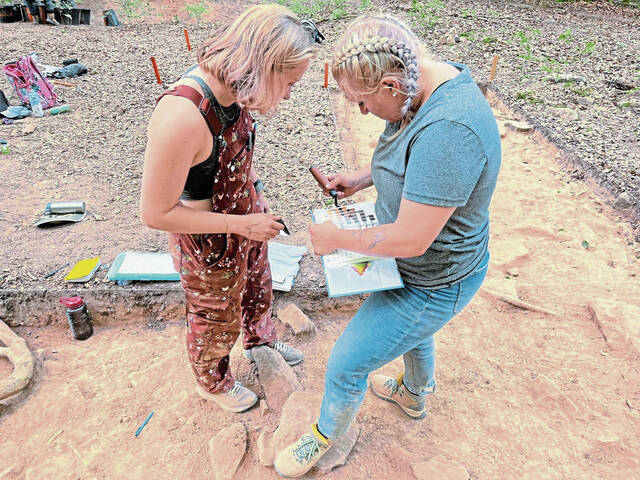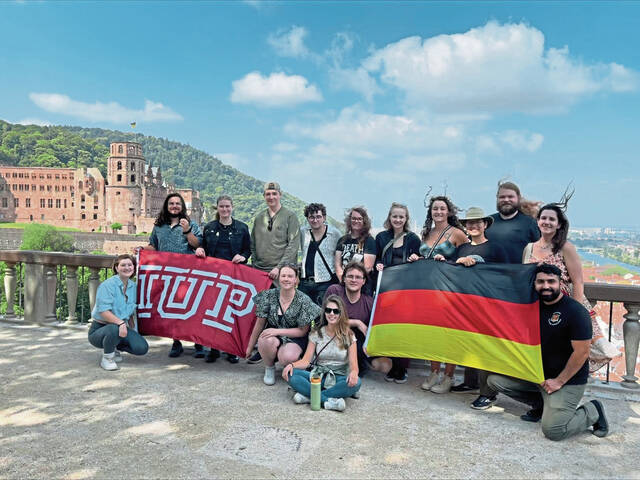IUP team investigates WWII bomber crash site in Germany
Among the trees of a national forest park near Frankfurt, Germany, survey lines, pin flags and neatly aligned squares of excavation dotted the ground in precise rows.
With ground-penetrating radar, metal detectors, mesh and a host of other tools, a team of undergraduate students and teaching assistants, led by faculty from Indiana University of Pennsylvania, were hard at work investigating a World War II bomber crash site.
The group, directed by IUP Department of Anthropology faculty members Andrea Palmiotto and William Chadwick, worked in conjunction with the Henry M. Jackson Foundation for the Advancement of Military Medicine Inc. through the Department of Defense POW/MIA Accounting Agency. The agency works to find “the fullest possible accounting for missing personnel from past conflicts of the United States.”
According to the agency, as of May, more than 81,000 Americans remain missing from WWII, the Korean War, the Vietnam War, the Cold War, the Gulf Wars and other conflicts. About 75% of the losses were in the Indo-Pacific region, and more than 41,000 of the missing are presumed lost at sea.
This was the third year that a group visited Germany to conduct field studies at WWII plane crash sites.
Eighteen U.S. team members participated, including three IUP students and one alum. They excavated material, conducted radar scans and studied the landscape to glean details about what happened at the site. For six weeks starting in early July, the team worked to find any evidence of the three soldiers who would have been on the B-17 plane when it crashed.
While the team can’t yet talk about details of what they found, as the material is under study at agency labs, faculty say the program was a great opportunity to give students hands-on experience with forensic archaeology, as well as the chance to contribute to real-world research.
“I love doing this as a field school,” Palmiotto said. “I used to work with the (agency) before I came to IUP, so I was familiar with the mission, but getting the chance to bring students out here and teach them while having them contribute to this mission is one of my favorite parts.”
“It is really meaningful to the families of the folks that were lost, as well as meaningful for the students who are involved,” said Ben Ford, chair of the anthropology department at IUP. “With archaeology and forensics, you never know exactly what you’re going to find. If you knew what you were going to find, we wouldn’t have to do the work. There’s a lot of unknowns.”
Archaeological investigation
As the team worked on the project, they kept an eye out for anything out of place. Debris could be indicative of what parts of the plane they might recover, said Chadwick, who did not travel to Germany this year but is a leader on the project.
“It helps to direct the direction of excavation,” Chadwick said. “There were three people in three different places (on the plane), and as you’re excavating, you’re looking at the material coming out. They might have had certain devices or equipment, and if you find that equipment, you’re getting closer to where the person was after the event.”
Every bit of dirt was screened, Palmiotto said.
“Some of the stuff is so small, we don’t want to miss it,” she said, adding that the group takes meticulous notes and specifies the GPS location of everything. The excavation is filled in at the end of the project, so detailed notes are important for future investigations, she said.
“We dig in these nice perfect squares, we lock them into the map exactly, precisely where they are.”
For students on the project, a typical day began with setting a plan, according to IUP teaching assistant Tyler Fanell. His role as a crew chief typically involved leading teams of students in the field, teaching excavation techniques and sharing his own experience through mentorship.
“My days typically consist of coordinating with the day’s field directives and excavation goals with (Dr. Palmiotto) and my colleague, Emily Sykora, the other crew chief. From there, me and my team begin excavations for the day,” Fanell said.
Students in the program are gaining valuable experience and contributing to an important mission at the same time, Fanell explained.
“The most rewarding part of this project has been being able to work with students, whose experiences with archaeological excavation range greatly, in helping them continue to learn field methods and greatly improve their excavation skills at the same time,” he said.
Teaching field skills
The project combines history, forensics and archaeology, Chadwick said. Students from all three fields contribute.
Participants learn field techniques on how to excavate, map and take notes on a site, as well as how to interpret those results to determine where to excavate next. Chadwick described it as resembling a “historical crime scene.”
“Anything that is evidentiary, which means bone or personal items, gets retained for the project,” he said. “The aircraft parts don’t get retained — the aircraft isn’t the important part of the mission. We send it to a recycler, all of the metal.”
Ford said IUP has a strong anthropology program, which helps to facilitate projects such as this one.
“A lot of what we do here is called applied anthropology — using anthropological approaches to solve real-world problems,” he said. “The folks who came before us did great stuff, and we’re kind of continuing that legacy and trying to train students to think about the world globally.”
Ramon Espinoza, a rising sophomore at Princeton University who participated in the project, said the field school teaches things that can’t be explained in the classroom.
“This experience has proven to be immensely beneficial for students interested in entering the fields of archaeology and offers a unique blend of theoretical knowledge and practical skills that are difficult — I would even argue impossible — to replicate in a classroom setting,” he said. “The opportunity to work on real-life cases with the (agency) enables us to understand the challenges and responsibilities associated with this line of work, too.”
A veteran, Espinoza takes the impact of the project very seriously.
“This multidisciplinary approach enhances our ability to interpret the findings more accurately, and to connect with the human stories behind the artifacts and remains — an especially meaningful aspect for me as a veteran of the war in Afghanistan,” he said. “It not only fosters a deep appreciation for the historical significance of our work, but also instills a sense of duty and responsibility in preserving our nation’s history and honoring those who have made the ultimate sacrifice.”
Julia Maruca is a TribLive reporter covering health and the Greensburg and Hempfield areas. She joined the Trib in 2022 after working at the Butler Eagle covering southwestern Butler County. She can be reached at jmaruca@triblive.com.
Remove the ads from your TribLIVE reading experience but still support the journalists who create the content with TribLIVE Ad-Free.




